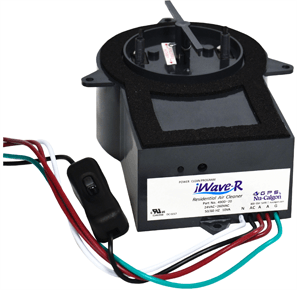
Indoor Air Quality in Bergen County, NJ

4.8
Review Score as of 1/19/24
Nothing is more important than the air you and your family breathe in your Bergen County, NJ home. At GRC Mechanical Services, we are pleased to offer our customers the state-of-the-art indoor air quality solution they deserve - the iWave-R air purification system. With technology installed in over 200,000 applications, iWave-R is the world’s first self-cleaning, no-maintenance needlepoint bi-polar ionization generator designed specifically for treating air in residential duct A/C systems. The iWave-R has been proven through independent lab testing to significantly reduce a wide variety of pathogens in the breathing zone and on hard non-porous surfaces, including the Human Coronavirus 229E.
How the iWave-R Works
As the air flows past the iWave-R, positive and negative ions actively purify the supply air, killing mold, bacteria, and viruses in the coil and living space. The ionization process also reduces allergens, smoke, and static electricity, as well as controls odors and other particles in the air without creating ozone or any harmful byproducts. iWave-R always works at peak performance, producing over 160 million ions/cc per polarity (320 million total ions/cc), more than any other ionizer product on the market. Its patented self-cleaning design includes a programmable cleaning cycle that can clean the emitter brushes every 1, 3, 5, or 10 days. The iWave-R is factory set to clean every third day, which is adequate for a typical installation. iWave-R does not create “black walls” as negative-only ionizer products will do.
Additional Features & Benefits of the iWave-R
iWave-R treats the air in any brand of residential duct air conditioning systems up to 6 tons (2400 CFM) in size with no maintenance and no replacement parts. Designed for universal mounting, the iWave-R typically installs inside or outside of the duct, or it attaches magnetically near the indoor fan in the air handler. Additional features include:
- Kills mold, bacteria, and viruses
- Reduces allergens, odors, smoke, static electricity, and other airborne particles
- Keeps coil cleaner
- Patented self-cleaning design ensures ongoing peak performance
- Needlepoint bi-polar ionization actively treats air in the living space
- Universal mounting with magnets
- Flexible design with no replacement parts
- Programmable cleaning cycle
- UL and cUL approved
- Three-year warranty*
*Nu-Calgon offers a three-year limited warranty on iWave products. For a valid warranty claim within three years, proof of purchase and proof of installation by a licensed HVAC or electrical contractor must be provided. See full warranty for complete details.

Trust GRC Mechanical Services for the indoor air quality solutions you need near Bergen County, NJ.
When you need advanced indoor air quality solutions for your home in Bergen County or nearby areas, GRC Mechanical Services is ready to help. Simply give us a call at 1-800-651-8222 or contact us online, and we will be more than happy to help you get the iWave-R air purification system for your home.
Additional Residential Services
As a full-service contractor, you can count on GRC Mechanical Services to provide you with the residential services you need. In addition to expert indoor air quality solutions, we’re also pleased to offer: